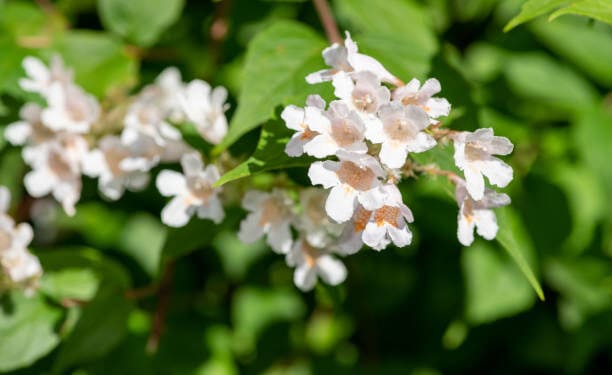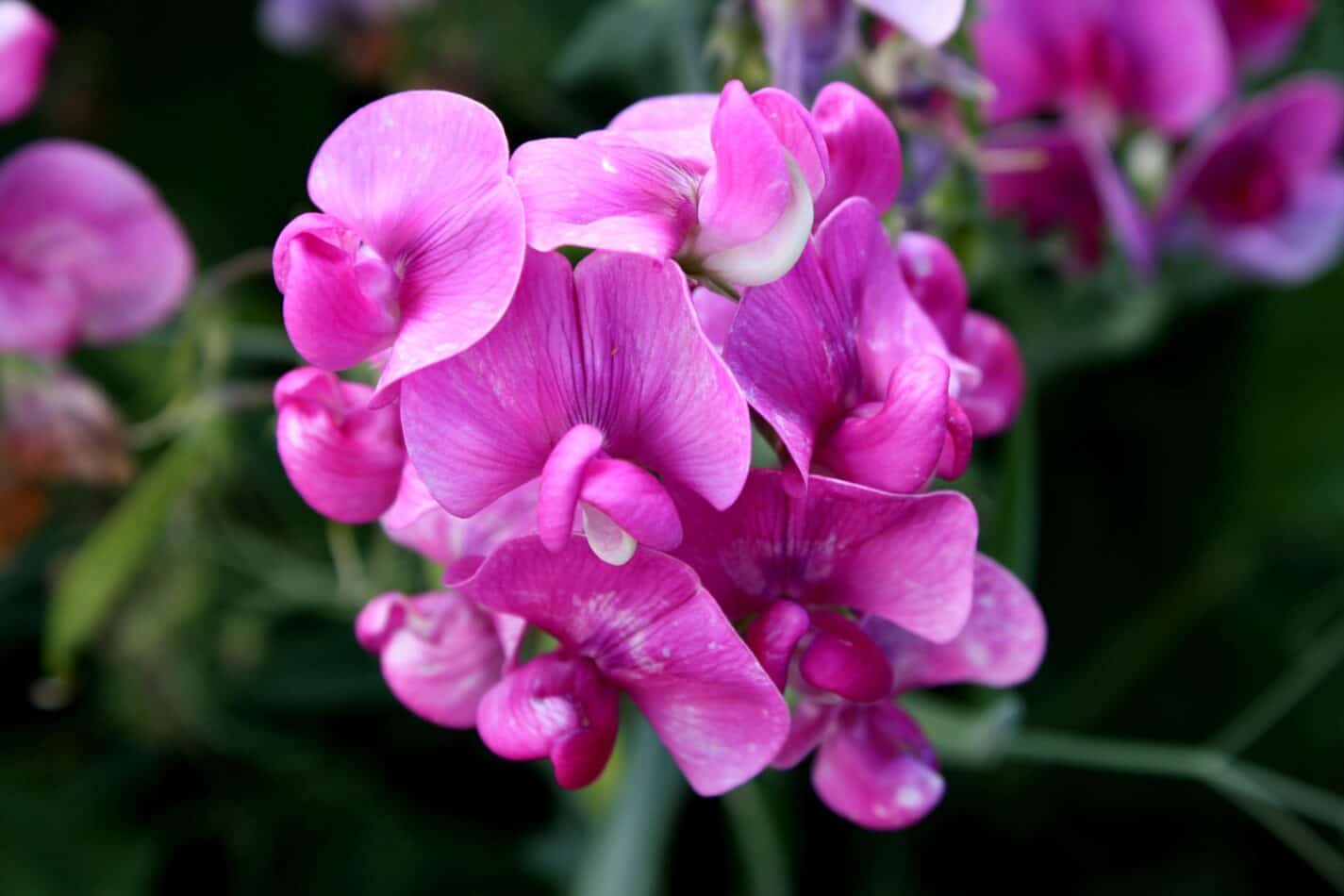The Kolkwitzia amabilis flower is a species of flowering shrub found in the honeysuckle family (Caprifoliaceae), native to China, Taiwan and Japan. It typically matures to a height of around 2.5m with slender, branching stems and arching branches, known as a vase-shaped habit. The Kolkwitzia amabilis is often referred to as the Beauty Bush or White Rain bush due to it’s graceful and beautiful appearance.
Etymology
Kolkwitzia amabilis is named after the German botanist, Dr. Richard Kolkwitz, who first studied and classified the species in 1889. The species name ‘amabilis’ translates to ‘loveable’, which is a fitting description for the plant given its beauty. The alternate old common name “Wild Balsam” is derived from the Latin family name for the species, BALSAMINACEAE.
How to Plant and Grow Beauty Bush
Beauty Bush is an upright deciduous shrub that can reach heights of up to 10 feet, making it catchy and fit for hedges or as a background plant at your garden. When planted, make sure to provide plenty of room for growth, as it is a fast-growing shrub. A sunny location is preferred, although some shade will work too, as long as the soil remains moist and not too soggy.
For a healthy and beautiful shrub, select a well-drained area with soil that is composted, moist and high in organic matter. A slightly acidic soil pH of between 5.5 and 6.5 will work best. Regular watering is important and applying a general fertilizer every other month may be beneficial as well.
Meaning and Symbolism
The beauty bush has often been associated with a few idealistic symbols such as beauty, hope, grace, friendship, long-term and true love, and peace. These traits have been attributed to the bright flowers during the blooming season, giving off a pleasing fragrance. The plant symbolizes friendship and happiness, and is also said to bring luck and prosperity to those who nurture it.
History, Mythology, and Religious Significance
The beauty bush is not just restricted to symbolizing beauty and grace alone. It also carries a long history and mythology. In Cuba, the bush is thought to be sacred and associated with the Santeria religion. Here it is seen as a symbol of liberation and augurs good fortune. The divine flowers form a part of private altars dedicated to the gods and a ceremony known as ‘Santeria.’
Mystical and divine properties aside, the beauty bush holds a significant place in Japanese culture, where it is named ‘Tatebush.’ Here, blossoms are offered to deities in homage, as expressions of joy and innocence.
Flower varieties and their defining characteristics
Kolkwitzia amabilis comprises at least 12 known varieties, which vary in hardiness, bloom-time, flowering color, and sun or shade requirements. These varieties include:
- Kolkwitzia amabilis ‘Swan Hill’ – This variety is barely hardy and grows well in the shade. Bloom-time is in April, and pink blooms are produced during this time.
- Kolkwitzia amabilis ‘Dream Catcher’ – This semi-hardy variety grows in sunny sun and is tolerant of drought conditions. Bloom-time is from July to September, with white flowers produced.
- Kolkwitzia amabilis ‘Mary Clements’ – This low-maintenance variety is rather hardy and grows in full sun. Bloom-time is in May, and pink flowers are produced.
- Kolkwitzia amabilis ‘White Cloud’ – Low maintenance and very hardy, this variety grows in full sun and blooms in June, with white flowers.
How to Pot and Repot
To pot and repot beauty bush, start by selecting a pot that is similar in size to the existing pot. Use a soil-less medium, such as peat and perlite, for best drainage. Once the pot is planted, water it thoroughly until the water runs out of the drainage holes or it reaches saturation.
Water the beauty bush on a regular basis, roughly every 3 to 5 days, or when the soil begins to look dry or feel dry to the touch. When repotting, it is best to do so in the summer during the growing season. This ensures that the soil does not become too dry or uneven in its nutrition for the beauty bush, which could result in stunted growth.
How to Prune
To keep your beauty bush looking full and healthy, pruning is important. Pruning can be done on both young plants and mature plants, and should largely be focused on thinning and removing diseased, dead or overgrown branches.
Start by cutting the diseased or dead branches from the plant and properly disposing of them. For young beauty bushes, the goal is to encourage lateral branching and shortening the shoots that have grown outside the desired range. For mature ones, you can cut thin branches down to their base in order to open up the center, which allows more exposure to sunlight and air.
How to Propagate
Propagating beautiful bush is relatively easy and can be done by both seed and cuttings. For cuttings use the tip of the stem that should be around 4 to 6 inches long.
When performing the propagation by cuttings, remove several nodes and dip the cut in a rooting hormone. Put the cutting in a mixture of soil and perlite approximately two-thirds of the stem length in. Put the stem where there is bright light and high humidity. After several weeks, the cutting should have roots, and you can now transfer to the desired location or pot in soil-less compost for potting.
Common Pests and Diseases
Beauty bush is relatively easy to look after and generally doesn’t suffer from any serious pest or diseases. The most common pests you should watch out for include aphids, which may leave a sticky residue on leaves, and whiteflies, which can lay eggs on the undersides of leaves.
The most common diseases that affect the beauty bush are phytophthora root rot and leaf spot, which is caused by fungi. To minimize the risk of these diseases, make sure to water the bush in the early morning so that the leaves have a chance to dry throughout the day. Additionally, use soil with good drainage and fertilize as needed.
Frequently Asked Questions
Q. How big will my Beauty Bush get?
A. Beauty Bush will get between 5 to 10 feet tall and wide, depending on the variety.
Q. How often should I prune my Beauty Bush?
A. Pruning is necessary to maintain the beauty of the bush and should generally be done once a year or after it finishes blooming.
Q. Will Beauty Bush do well in full sun or partial shade?
A. Beauty Bush does best in full sun conditions, however it also does well in partial shade.
Fact Sheet
| Flower | Details |
|---|---|
| Beauty Bush | Kolkwitzia Amabilis |
| Family | Caprifoliaceae |
| Plant Type | Shrub |
| Mature Size | 5 to 10 feet tall and wide |
| Sun Exposure | Full sun to partial shade |
| Soil Type | Well-drained, moist soil |
| Soil pH | 5.5 – 6.5 |
| Bloom Time | Varies by variety (April – September) |
| Flower Color | Varies by variety (pink, white) |
| Hardiness Zones | Varies by variety (hardy and semi-hardy) |
| Native Area | China, Taiwan and Japan |
What we love from Amazon this week
Buy these wonderful flowers directly from Amazon:















